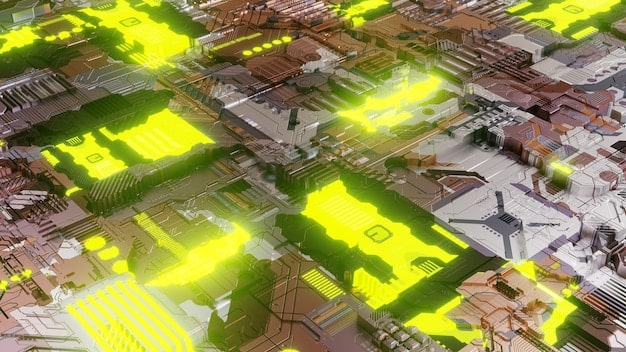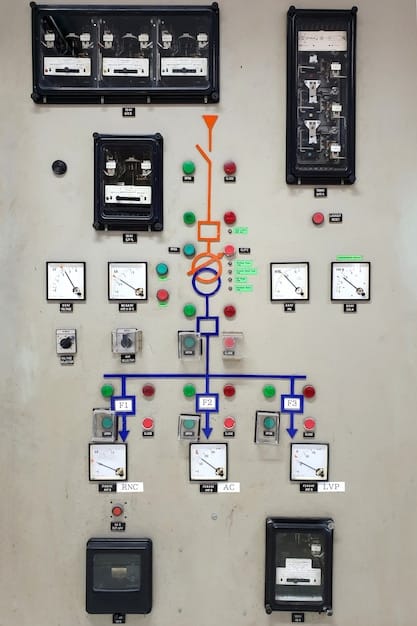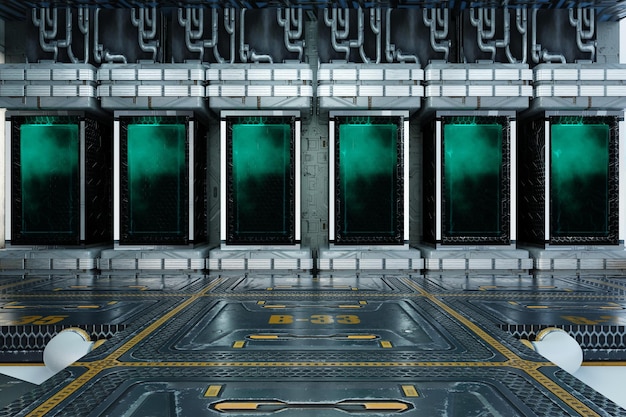Critical Infrastructure Alert: CISA Warns of ICS Vulnerability

CISA has issued a critical infrastructure alert regarding a newly discovered vulnerability in Industrial Control Systems (ICS), urging immediate action to mitigate potential risks.
A Critical Infrastructure Alert: CISA Issues Urgent Warning About New ICS Vulnerability. The Cybersecurity and Infrastructure Security Agency (CISA) has raised concerns about a significant vulnerability affecting Industrial Control Systems (ICS), which are vital for the operation of critical infrastructure sectors in the United States.
Understanding the CISA Alert on ICS Vulnerabilities
The Cybersecurity and Infrastructure Security Agency (CISA) plays a crucial role in safeguarding the nation’s critical infrastructure. When CISA issues an alert, especially one concerning Industrial Control Systems (ICS), it’s vital to understand the context and potential impact.
This section will delve into the specifics of the alert, the nature of ICS vulnerabilities, and why they pose such a significant threat to the U.S.
What are Industrial Control Systems (ICS)?
Industrial Control Systems (ICS) are a collection of hardware and software used to control and automate industrial processes. These systems are found in a wide range of critical infrastructure sectors, from energy and water to transportation and manufacturing.
ICS components include:
- Supervisory Control and Data Acquisition (SCADA) systems: Used for large-scale monitoring and control.
- Programmable Logic Controllers (PLCs): Used to automate specific processes.
- Human-Machine Interfaces (HMIs): Provide operators with a visual interface to monitor and control the system.
Why are ICS Vulnerabilities a Major Concern?
ICS vulnerabilities can have devastating consequences because they directly impact the physical processes that these systems control. A successful attack could lead to:
- Disruptions in essential services: Affecting power grids, water supplies, and transportation networks.
- Physical damage to equipment: Causing costly repairs and downtime.
- Environmental disasters: Resulting from uncontrolled industrial processes.
Furthermore, the aging infrastructure and increasing connectivity of ICS make them more vulnerable to cyberattacks. Many ICS were not designed with security in mind, leading to inherent weaknesses that can be exploited by malicious actors.

In conclusion, understanding the nature of ICS and the potential impact of their vulnerabilities is critical for appreciating the significance of CISA’s alert. These systems are the backbone of essential services, and their security is paramount.
Details of the Specific Vulnerability
To fully grasp the urgency of CISA’s alert, it’s essential to examine the specific vulnerability in question. While the details of each vulnerability vary, understanding the common characteristics and potential exploits can help organizations prepare their defenses.
This section will delve into the common types of ICS vulnerabilities and discuss how attackers typically exploit them.
Common Types of ICS Vulnerabilities
ICS vulnerabilities can stem from various sources, including software flaws, misconfigurations, and weak security practices. Some of the most common types include:
- Lack of authentication: Allowing unauthorized access to critical systems.
- Weak encryption: Exposing sensitive data transmitted over the network.
- Default passwords: Providing easy access for attackers who can guess or find the default credentials.
How Attackers Exploit ICS Vulnerabilities
Attackers often use a multi-stage approach to exploit ICS vulnerabilities. This may involve:
- Reconnaissance: Gathering information about the target system, including its architecture, software versions, and network configuration.
- Exploitation: Using known vulnerabilities or zero-day exploits to gain access to the system.
- Lateral movement: Moving from compromised systems to other critical components within the network.
It’s crucial to note that some vulnerabilities are specific to certain ICS vendors or products. CISA’s alert would typically provide specifics about the vulnerability, including the Common Vulnerabilities and Exposures (CVE) identifier, which provides detailed information on the vulnerability.
In summary, understanding the types of vulnerabilities and how attackers exploit them is crucial for developing effective mitigation strategies. By staying informed and proactive, organizations can reduce their risk of falling victim to ICS-related cyberattacks.
Impact on Critical Infrastructure Sectors
The potential impact of ICS vulnerabilities extends across various critical infrastructure sectors, each with its unique set of risks and challenges. Understanding these sector-specific impacts is essential for tailoring security measures and response plans.
This section will explore the potential consequences in key sectors such as energy, water, and transportation.

Energy Sector
In the energy sector, ICS vulnerabilities can lead to:
- Power outages: Disrupting electricity supply to homes and businesses.
- Damage to power generation equipment: Requiring costly repairs and potentially leading to long-term supply shortages.
- Blackmail: Threaten to disrupt energy supplies unless ransoms are paid.
Water Sector
ICS vulnerabilities can compromise the safety and reliability of water supplies. The potential impact includes:
- Contamination of drinking water: Endangering public health.
- Disruptions in water treatment processes: Leading to water shortages and sanitation issues.
- Damage to water infrastructure: Such as pumps and pipelines, causing long-term service disruptions.
Transportation Sector
ICS vulnerabilities pose a direct threat to the safety and efficiency of transportation systems. The potential consequences include:
- Disruptions to air traffic control systems: Leading to flight delays and cancellations.
- Compromised railway signaling systems: Potentially causing train collisions and derailments.
- Interference with traffic management systems: Resulting in traffic jams and increased accident risks.
Ultimately, the impact on each sector depends on the specific vulnerabilities, the security measures in place, and the effectiveness of the response plan. A proactive approach to security and incident response is essential for minimizing the risks and protecting critical infrastructure.
CISA’s Recommendations for Mitigation
When CISA issues a critical infrastructure alert, it accompanies a set of recommendations for mitigating the identified vulnerabilities. These recommendations are designed to help organizations take immediate action to protect their systems and data.
This section will explore the key recommendations from CISA and outline the steps organizations should take.
Key Recommendations from CISA
CISA’s recommendations typically include a combination of technical and procedural measures, such as:
- Patching vulnerable systems: Applying security updates as soon as they are available.
- Implementing strong authentication: Requiring multi-factor authentication for access to critical systems.
- Segmenting networks: Isolating ICS networks from corporate IT networks to limit the spread of potential attacks.
Steps Organizations Should Take
To effectively implement CISA’s recommendations, organizations should take the following steps:
- Review the alert: Understand the specific vulnerabilities and the recommended mitigation strategies.
- Assess their systems: Identify all systems that may be affected by the vulnerability.
- Prioritize actions: Focus on the most critical systems and vulnerabilities first.
Importance of Continuous Monitoring and Incident Response
Mitigation is not a one-time event but an ongoing process. Organizations should implement continuous monitoring to detect potential attacks and develop incident response plans to effectively respond to security incidents.Regularly review security logs and monitor network traffic for suspicious activity.
A well-defined incident response plan should include clear roles and responsibilities, procedures for containing and eradicating attacks, and steps for recovering affected systems. By taking these steps, organizations can significantly reduce their risk of falling victim to ICS-related cyberattacks and protect their critical infrastructure.
The Broader Cybersecurity Landscape
The CISA alert regarding ICS vulnerabilities is just one piece of a much larger cybersecurity landscape. To effectively protect critical infrastructure, organizations must understand the broader trends and threats that are shaping the cybersecurity environment.
This section will explore the evolving threat landscape and provide an overview of the key challenges and trends in cybersecurity.
Evolving Threat Landscape
The threat landscape is constantly evolving, with attackers developing new techniques and exploiting new vulnerabilities. Some of the key trends include:
- Ransomware attacks: Increasingly targeting critical infrastructure sectors.
- Nation-state actors: Engaging in cyber espionage and sabotage.
- Supply chain attacks: Targeting vulnerabilities in third-party software and hardware.
Key Challenges in Cybersecurity
Organizations face several challenges in their efforts to secure their systems and data, including:
- Shortage of skilled cybersecurity professionals: Making it difficult to find and retain qualified staff.
- Complexity of modern IT environments: Increasing the attack surface and making it harder to detect threats.
- Lack of awareness among employees: Making them vulnerable to phishing and social engineering attacks.
The importance of cybersecurity awareness and training cannot be overstated. Educating employees about the latest threats and best practices can significantly reduce the risk of successful attacks. Organizations should also invest in security technologies, such as intrusion detection systems and security information and event management (SIEM) tools, to help detect and respond to cyber threats.
Future of ICS Security
As technology continues to evolve, the future of ICS security will depend on the ability of organizations to adapt to emerging threats and embrace new security strategies. Innovation and collaboration between industry stakeholders and government agencies will be critical for securing critical infrastructure in the years to come.
This section will explore the emerging trends and technologies that are shaping the future of ICS security, as well as the role of collaboration and information sharing.
Emerging Trends and Technologies
Several emerging trends and technologies are poised to transform ICS security, including:
- Artificial intelligence (AI) and machine learning (ML): Using AI and ML to detect and respond to cyber threats in real-time.
- Blockchain technology: Enhancing the security and integrity of ICS data.
- Zero-trust security models: Implementing stricter access controls and authentication requirements.
Role of Collaboration and Information Sharing
Collaboration and information sharing are essential for improving ICS security. By sharing threat intelligence and best practices, organizations can collectively strengthen their defenses and reduce the risk of successful attacks. CISA plays a critical role in facilitating information sharing and coordinating incident response efforts.
- Organizations should participate in industry-specific information sharing groups.
- Sharing timely and relevant information with trusted partners.
In the future, the success of ICS security will depend on the ability of organizations to embrace new technologies, foster collaboration, and maintain a proactive and adaptive security posture. By working together and staying informed, we can protect critical infrastructure from cyber threats and ensure the safety and well-being of our communities.
| Key Aspect | Brief Description |
|---|---|
| 🚨 CISA Alert | CISA issued an urgent warning about a new vulnerability in Industrial Control Systems (ICS). |
| 🛡️ Mitigation | Organizations should patch systems, implement strong authentication, and segment networks. |
| 💡 ICS Security | AI, machine learning, and blockchain are poised to transform ICS security. |
| 🤝 Collaboration | Collaboration and information sharing are essential for improving ICS security. |
Frequently Asked Questions
▼
ICS are systems used to control and automate industrial processes. They are found in critical infrastructure sectors like energy, water, and transportation, managing key operations.
▼
CISA issues alerts to notify organizations about significant cybersecurity threats to infrastructure, urging immediate action to mitigate potential risks and protect systems.
▼
Common vulnerabilities include lack of authentication, weak encryption, and default passwords. Attackers exploit these to gain unauthorized access to sensitive systems and disrupt operations.
▼
Organizations should patch vulnerable systems, implement strong authentication, segment networks, and continuously monitor for threats. Developing and testing incident response plans is also critical.
▼
Collaboration and information sharing are essential for improving ICS security by enabling organizations to share threat intelligence, best practices, and coordinate incident response efforts.
Conclusion
The recent CISA alert regarding vulnerabilities in Industrial Control Systems underscores the critical need for heightened cybersecurity measures across all sectors. Organizations must remain vigilant, implement CISA’s recommendations, and embrace a proactive approach to protect their valuable assets and infrastructure from evolving cyber threats.





